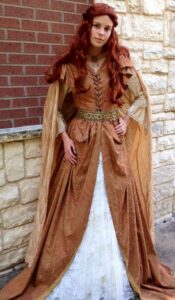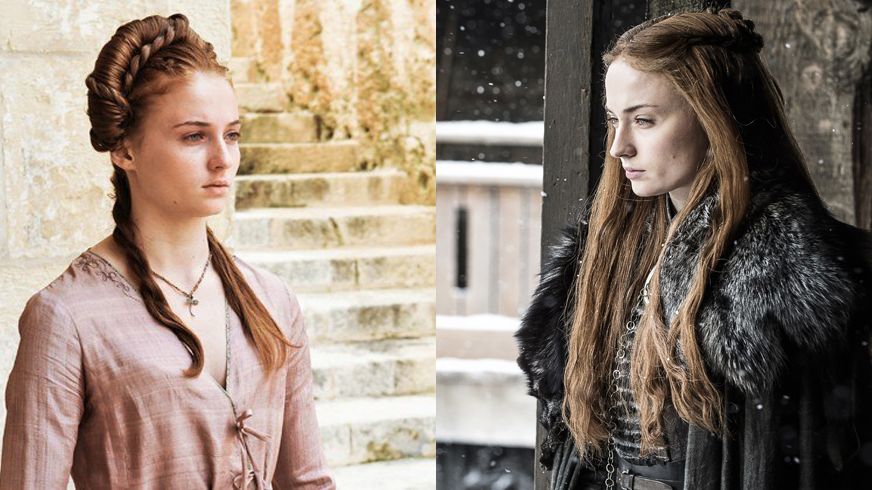Sansa Stark Clothes: A Complete Guide to Her Costume Evolution
Sansa Stark clothes hold a special place in the legacy of Game of Thrones. Her costumes are not random designs but carefully constructed storytelling tools. Every fabric choice, embroidery stitch, and accessory illustrates her political position, emotional state, and cultural environment. Understanding Sansa’s clothes offers insight into how costume design communicates character evolution without words.
The Stark Identity in Fabric and Form:
Sansa Stark’s clothes in Winterfell reflect her Northern heritage. The Stark family favors practicality over luxury. Heavy wool cloaks, layered tunics, and fur-lined gowns dominate the early seasons. These designs showcase resilience against harsh Northern winters.
-
Wool emphasizes durability.
-
Fur conveys Stark nobility.
-
Neutral greys and blues represent loyalty.
-
Embroidery shows Stark women’s skill in handcraft.
Her first dresses carry subtle wolf motifs that root her identity in Winterfell tradition.
Transformation in King’s Landing:
Arrival in King’s Landing shifts Sansa’s clothes into Southern court fashion. Lightweight silks, satins, and flowing gowns replace Northern furs. The silhouette becomes more elegant with structured bodices and wider sleeves.
-
Pale pastels symbolize youth and naivety.
-
Lannister red and gold appear in trims.
-
Jewelry becomes elaborate, reflecting court standards.
-
Hairstyles mimic Cersei Lannister’s, showing political pressure.
These garments represent assimilation into a dangerous political world, where appearance equates to survival.
Influence of Cersei Lannister:
Cersei’s dominance is visible in Sansa Stark’s clothes. Dresses take on deeper necklines and richer fabrics. Gold threading and lion embroidery signal Lannister control over her identity. The mimicry of hairstyle is deliberate—an outward reflection of forced obedience.
Tyrell-Inspired Fashion Shift:
Under the Tyrell influence, Sansa’s wardrobe softens. Dresses appear in greens, yellows, and soft floral tones. Rose embroidery becomes frequent, aligning her image with House Tyrell’s political ambitions. These designs highlight her role as a potential bride in strategic alliances.
Marriage Wardrobe: Union with Tyrion Lannister:
During her marriage to Tyrion, Sansa Stark clothes blend Northern modesty with Lannister symbolism. Royal purples dominate, reflecting forced nobility. Heavy embroidery mixes wolves and lions, subtly depicting her inner conflict.
-
Purple represents royal marriage.
-
Embroidery combines two houses.
-
Fabrics include brocade and velvet.
-
Heavier headpieces mark ceremonial dignity.
This period shows Sansa trapped between two worlds.
Hidden Identity in the Vale:
Disguise becomes the central theme in the Vale of Arryn. Clothes darken into greys and blacks, removing all Southern extravagance. High collars and plain linen keep her identity masked. Raven embroidery signals Petyr Baelish’s control and mentorship.
The Black Feather Dress:
The black feather dress stands as a milestone in Sansa’s transformation. Feathers stitched across the bodice symbolize the mockingbird sigil of Littlefinger and Sansa’s growing secrecy. Dark fabrics present her as a strategist rather than a pawn.
Return to Winterfell: Reclaiming Stark Heritage
When Sansa returns to Winterfell, her clothes reassert Stark identity. Heavy wool cloaks, fur shoulders, and darker tones dominate. Embroidery features direwolves, reinforcing loyalty to her family.
-
Fur capes declare leadership.
-
Dark tones reflect resilience.
-
Layered gowns show Stark practicality.
-
Chain clasps display Northern authority.
The wardrobe now projects strength rather than innocence.
Rise as Lady of Winterfell:
As Lady of Winterfell, Sansa wears hybrid garments that mix regal gowns with armor-like bodices. The clothes show readiness for war and governance. Chain accessories reinforce her political weight.
The Queen in the North Gown:
The final Queen in the North gown is the pinnacle of Sansa Stark clothes. Designed in deep grey, the gown incorporates scale-like embroidery, fur elements, and metallic threads. A direwolf sigil anchors the design, while a crown completes the transformation.
-
Scale embroidery mirrors armor.
-
Metallic thread signals sovereignty.
-
Fur pieces connect to Stark heritage.
-
Crown elevates her as Queen of the North.
This outfit concludes her journey from innocence to authority.
Symbolism in Color Evolution:
Colors across Sansa Stark clothes map her personal transformation.
-
Grey = Stark roots.
-
Blue = innocence.
-
Pastels = Southern assimilation.
-
Purple = forced nobility.
-
Black = secrecy and disguise.
-
Deep grey with metallic = sovereignty.
Each stage visually narrates her path from captive to queen.
Embroidery as Hidden Language:
Embroidery in Sansa’s gowns communicates silent messages. Wolves, roses, lions, and ravens tell the story of her alliances and influences. Costume designer Michele Clapton confirmed embroidery served as symbolic storytelling.
Materials and Textures:
Different materials reflect cultural geography in Game of Thrones:
-
Wool and fur = North.
-
Silk and satin = South.
-
Linen = Vale.
-
Leather = hybrid armor styles.
Each textile choice grounds Sansa in the political geography of Westeros.
Historical Inspirations:
Sansa Stark clothes borrow from medieval Europe.
-
Northern furs draw from Norse traditions.
-
Southern gowns echo Tudor courts.
-
Feather motifs connect to Gothic design.
-
High collars recall late medieval aristocracy.
The authenticity deepens immersion in Westeros.
Cultural Legacy of Sansa Stark Clothes:
Sansa Stark’s wardrobe influenced global fashion. Designers incorporated medieval embroidery into runway collections. Cosplayers frequently recreate her black feather dress and Queen gown. Exhibitions display her costumes as works of art.
Comparing Sansa Stark Clothes with Arya Stark Clothes:
Sansa emphasizes embroidery and politics. Arya emphasizes practicality and survival. Sansa wears gowns; Arya wears leather tunics. The contrast highlights their divergent paths within the same family.
Sansa Stark Clothes vs Daenerys Targaryen Clothes:
Sansa Stark’s palette is muted and Northern. Daenerys’ wardrobe uses whites, blues, and dragon-scale motifs. Sansa reflects stability of the North; Daenerys reflects ambition of conquest.
Role of Michele Clapton:
Michele Clapton designed every stage of Sansa Stark’s clothes. She integrated storytelling, historical references, and hidden symbolism. Her work earned multiple Emmy Awards and global recognition.
Table: Evolution of Sansa Stark Clothes in Game of Thrones
| Stage / Location | Main Fabrics Used | Colors & Symbolism | Embroidery & Motifs | Key Influence / Meaning |
|---|---|---|---|---|
| Winterfell (Early) | Wool, Fur, Linen | Grey & Blue = Stark loyalty, innocence | Direwolf motifs, hand embroidery | Represents Northern heritage & family |
| King’s Landing (Arrival) | Silk, Satin, Velvet | Pastels = youth, naivety | Lions, floral trims | Adaptation to Lannister court fashion |
| Cersei Influence | Silk, Brocade, Goldwork | Red & Gold = Lannister dominance | Lion sigils, heavy jewelry | Forced mimicry of Cersei’s authority |
| Tyrell Influence | Light Silk, Satin | Green & Yellow = alliance with Tyrells | Roses & floral embroidery | Represents hope and political pawn role |
| Marriage to Tyrion | Velvet, Brocade, Silk | Purple = forced nobility, union | Wolves + Lions blended | Shows trapped dual identity |
| Vale of Arryn | Linen, Plain Wool | Grey & Black = secrecy, loss of innocence | Raven motifs | Baelish’s manipulation & disguise |
| Black Feather Dress | Feathers, Dark Silk | Black = transformation, strategy | Mockingbird symbolism | Marks shift to political strategist |
| Return to Winterfell | Wool, Fur, Leather | Dark Grey = resilience & leadership | Direwolf embroidery | Reclaims Stark identity |
| Lady of Winterfell | Leather, Wool, Fur | Dark Tones = strength, survival | Chains & Wolf sigil | Shows role as military and political head |
| Queen in the North | Wool, Leather, Metallics | Deep Grey & Silver = sovereignty & power | Scale patterns, direwolf crest | Final transformation into true ruler |
Conclusion:
Sansa Stark clothes form one of the most complete visual character arcs in modern television. From fur-lined Stark dresses to the Queen in the North gown, her costumes narrate survival, identity, and authority. Every detail, from fabric to embroidery, is part of a language of power.




